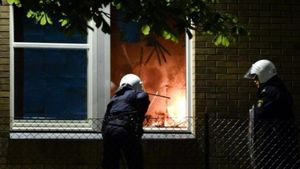On Wednesday night, tragedy struck when American Airlines Flight 5342 collided with an Army Black Hawk helicopter near Washington D.C.'s Reagan National Airport, instantly killing all 67 people aboard. This collision has been labeled the deadliest U.S. air disaster since 2001, with investigators currently piecing together the circumstances leading up to the crash.
The regional jet, which originated from Wichita, Kansas, was on approach for landing, carrying 60 passengers and four crew members. Minutes before the crash, air traffic controllers had advised the flight to use a shorter runway, to which the pilots agreed. Just moments before the collision, the helicopter was on a routine training mission and was reported to have the plane within sight.
Despite the clear skies, disaster struck when communication between the air traffic control tower and the military helicopter lapsed. According to reports, after the helicopter acknowledged it had the plane in sight, air traffic control urged relaying information to wait for the jet to pass. This communication, tragically, went unanswered as the two aircraft collided, plunging both vehicles and their occupants toward the Potomac River.
By Monday, recovery crews had managed to recover 55 bodies from the tragic scene, leaving only 12 more yet to be identified. Washington, D.C. Fire and EMS Chief John Donnelly stated authorities remain confident they will recover the remaining victims. Over 300 responders are aiding the efforts, employing divers, and utilizing Navy barges to assist with lifting heavy wreckage from the river.
The jet was found overturned, broken apart, and submerged, whereas the debris from the helicopter has also been spotted. Recoveries of human remains are of utmost priority, showcasing the significant respect for the deceased as salvage crews adhere strictly to protocols when retrieving evidence from the crash site.
Among the victims were members of the Skaters Club of Boston, who had just attended the 2025 U.S. Figure Skaking Championships, alongside other passengers, including families returning from various trips and hunting expeditions. The grieving process began as families arrived at the site, taken to the crash zone by buses under police escort. The emotional toll has been immense, as survivors grapple with the reality of their sudden loss.
Military officials have identified the helicopter's crew as three experienced soldiers: Capt. Rebecca M. Lobach from Durham, North Carolina; Staff Sgt. Ryan Austin O’Hara from Lilburn, Georgia; and Chief Warrant Officer 2 Andrew Loyd Eaves of Great Mills, Maryland.
Early investigations from the National Transportation Safety Board (NTSB) revealed conflicting altitude readings from both aircraft—Flight 5342 had been flying at about 325 feet, whereas the Black Hawk was operating at the maximum allowable altitude of 200 feet. Just seconds before the impact, the jet's flight recorder indicated it had changed its pitch, which could imply the pilots attempted to evade the oncoming helicopter; yet this remains unconfirmed.
The full scope of the investigation is expected to take several months, with preliminary reports anticipated within 30 days. This lengthy process is standard procedure for the NTSB, especially due to the significance of the incident. All five air traffic controllers on duty during the collision have been interviewed as part of the investigation.
President Donald Trump has remarked on the incident, attributing some fault to the helicopter’s altitude, and even connecting it to federal diversity and inclusion initiatives. While highlighting systemic issues, he struggled to provide sufficient evidence backing his claims when pressed by reporters.
Despite these external discussions, officials stress the importance of maintaining focus on the victims and their families during this time of healing. Washington D.C. has not seen such disaster since the events of 2001, when 260 lives were lost due to another tragic crash.
While air travel remains one of the safest means of transportation, the unique challenges of operating within the busy airspace surrounding D.C. can pose significant risks even to seasoned pilots. This incident serves as a solemn reminder of the potential dangers within modern aviation logistics.
Overall, the resilience of both recovery teams and bereaved families will be integral as the community continues to navigate through the aftermath of this heartbreaking event, bringing to light issues warranting attention from federal aviation authorities.



